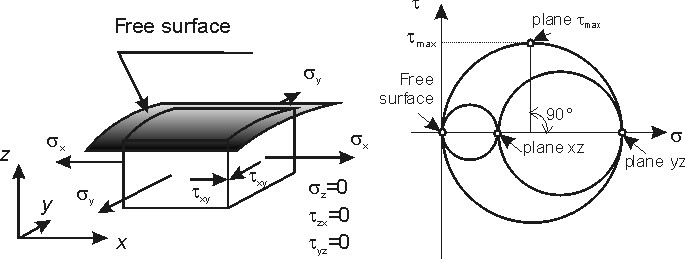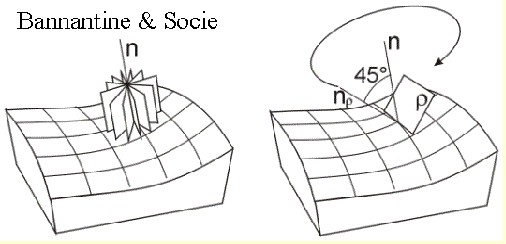
Bannantine-Socie concept
In: Examined planes
The proposal of Bannantine & Socie [BS91] originated from the knowledge, that the load state anywhere on the surface, where is no contact pressure active, is the plane stress state. This is described on the following two pictures:

There is one condition, so that the both picture were valid simultaneously – the both normal stresses in the left picture have to be principal stresses, thus the only shear stress active is also zeroed. The Mohr’s circles on the right side can be examined from two perspectives. If the shear stress is decisive, the plane with its maximum value is the most important plane. The other case corresponds to the expectation, that the highest principal stress governs the damaging process – this is the plane yz in the Mohr’s circle. The mutual relation of the non-zero stresses in the point examined are not so clear as was the condition in the start of this paragraph. This is the reason why all the following planes inclined from the normal line of the free surface have to be examined:

This assumption allows a significant reduction of the number of planes that have to be examined in critical plane methods in comparison to both globe analogy and random concepts. The option Number of scanned planes of the Calculation Methods dialogue describes number of planes examined on each value of the inclination of examined normal line from the normal line to the surface. There is one very important aspect - the switch of the option Optimize <1~yes, 0~no> on in the Calculation Methods dialogue runs the optimization in the search for the maximum value only in these two inclinations.
There are some limitations of the Bannantine-Socie concept. First, we are working on a discrete mesh of the FE-model, not on some real surface. The error in setting the normal line direction thus can mark the accuracy of the result. The second objection is, that not all calculation methods gives the maximum damage in any of the two modes described above.
More:
© PragTic, 2007
This help file has been generated by the freeware version of HelpNDoc